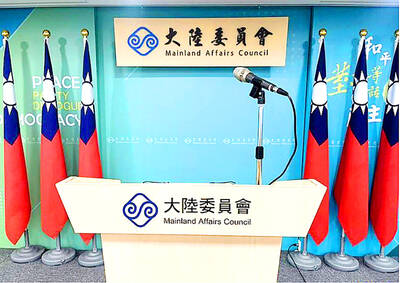The New York Times is suing Microsoft Corp and OpenAI Inc for using its content to help develop artificial intelligence (AI) services, in a sign of the increasingly fraught relationship between the media and a technology that could upend the news industry.
The technology firms rely on millions of copyrighted articles to train chatbots such as OpenAI’s ChatGPT and other AI features, allegedly causing billions of US dollars in statutory and actual damages, according to a lawsuit filed in New York on Wednesday.
The New York Times did not specify its monetary demands.

Photo: EPA-EFE
AI TRAINING
OpenAI has faced criticism for scraping text widely from the Web to train its popular chatbot since it debuted a year ago. While it has been sued by prominent authors, this is the first challenge to its practices by a major media organization.
The start-up has sought licensing deals with publishers, much like Alphabet Inc’s Google and Meta Platforms Inc’s Facebook have done.
The lawsuit says the publisher reached out to Microsoft and OpenAI in April and could not reach an amicable solution.
“We respect the rights of content creators and owners and are committed to working with them to ensure they benefit from AI technology and new revenue models,” an OpenAI spokesperson said in a statement. “Our ongoing conversations with the New York Times have been productive and moving forward constructively, so we are surprised and disappointed with this development.”
Microsoft declined to comment.
LAWSUITS
OpenAI in July signed an agreement with The Associated Press to access some of the news agency’s archives. OpenAI cut a three-year deal this month with Axel Springer SE to use the German media company’s work for an undisclosed sum.
“We’re hopeful that we will find a mutually beneficial way to work together, as we are doing with many other publishers,” the OpenAI spokesperson said.
OpenAI has been the target of multiple lawsuits from content producers complaining that their work has been improperly used for AI training. The company faces class actions from cultural figures, including comedian Sarah Silverman, Game of Thrones author George R.R. Martin and Pulitzer Prize-winning author Michael Chabon.
The cases are still in their early stages and could take years to fully resolve. A judge in San Francisco earlier this month hinted at trimming Silverman’s copyright lawsuit against OpenAI. The judge had already narrowed a similar Silverman suit against Meta.
Microsoft is OpenAI’s largest backer and has deployed the start-up’s AI tools in several of its products. In the lawsuit, the New York Times alleged that Microsoft copied the newspaper’s articles verbatim for its Bing search engine and used OpenAI’s technology to boost its value by US$1 trillion dollars.
“If Microsoft and OpenAI want to use our work for commercial purposes, the law requires that they first obtain our permission,” a New York Times spokesperson said in an e-mailed statement. “They have not done so.”

CHIP WAR: The new restrictions are expected to cut off China’s access to Taiwan’s technologies, materials and equipment essential to building AI semiconductors Taiwan has blacklisted Huawei Technologies Co (華為) and Semiconductor Manufacturing International Corp (SMIC, 中芯), dealing another major blow to the two companies spearheading China’s efforts to develop cutting-edge artificial intelligence (AI) chip technologies. The Ministry of Economic Affairs’ International Trade Administration has included Huawei, SMIC and several of their subsidiaries in an update of its so-called strategic high-tech commodities entity list, the latest version on its Web site showed on Saturday. It did not publicly announce the change. Other entities on the list include organizations such as the Taliban and al-Qaeda, as well as companies in China, Iran and elsewhere. Local companies need

CRITICISM: It is generally accepted that the Straits Forum is a CCP ‘united front’ platform, and anyone attending should maintain Taiwan’s dignity, the council said The Mainland Affairs Council (MAC) yesterday said it deeply regrets that former president Ma Ying-jeou (馬英九) echoed the Chinese Communist Party’s (CCP) “one China” principle and “united front” tactics by telling the Straits Forum that Taiwanese yearn for both sides of the Taiwan Strait to move toward “peace” and “integration.” The 17th annual Straits Forum yesterday opened in Xiamen, China, and while the Chinese Nationalist Party’s (KMT) local government heads were absent for the first time in 17 years, Ma attended the forum as “former KMT chairperson” and met with Chinese People’s Political Consultative Conference Chairman Wang Huning (王滬寧). Wang

CROSS-STRAIT: The MAC said it barred the Chinese officials from attending an event, because they failed to provide guarantees that Taiwan would be treated with respect The Mainland Affairs Council (MAC) on Friday night defended its decision to bar Chinese officials and tourism representatives from attending a tourism event in Taipei next month, citing the unsafe conditions for Taiwanese in China. The Taipei International Summer Travel Expo, organized by the Taiwan Tourism Exchange Association, is to run from July 18 to 21. China’s Taiwan Affairs Office spokeswoman Zhu Fenglian (朱鳳蓮) on Friday said that representatives from China’s travel industry were excluded from the expo. The Democratic Progressive Party government is obstructing cross-strait tourism exchange in a vain attempt to ignore the mainstream support for peaceful development

DEFENSE: The US would assist Taiwan in developing a new command and control system, and it would be based on the US-made Link-22, a senior official said The Ministry of National Defense is to propose a special budget to replace the military’s currently fielded command and control system, bolster defensive resilience and acquire more attack drones, a senior defense official said yesterday. The budget would be presented to the legislature in August, the source said on condition of anonymity. Taiwan’s decade-old Syun An (迅安, “Swift Security”) command and control system is a derivative of Lockheed Martin’s Link-16 developed under Washington’s auspices, they said. The Syun An system is difficult to operate, increasingly obsolete and has unresolved problems related to integrating disparate tactical data across the three branches of the military,